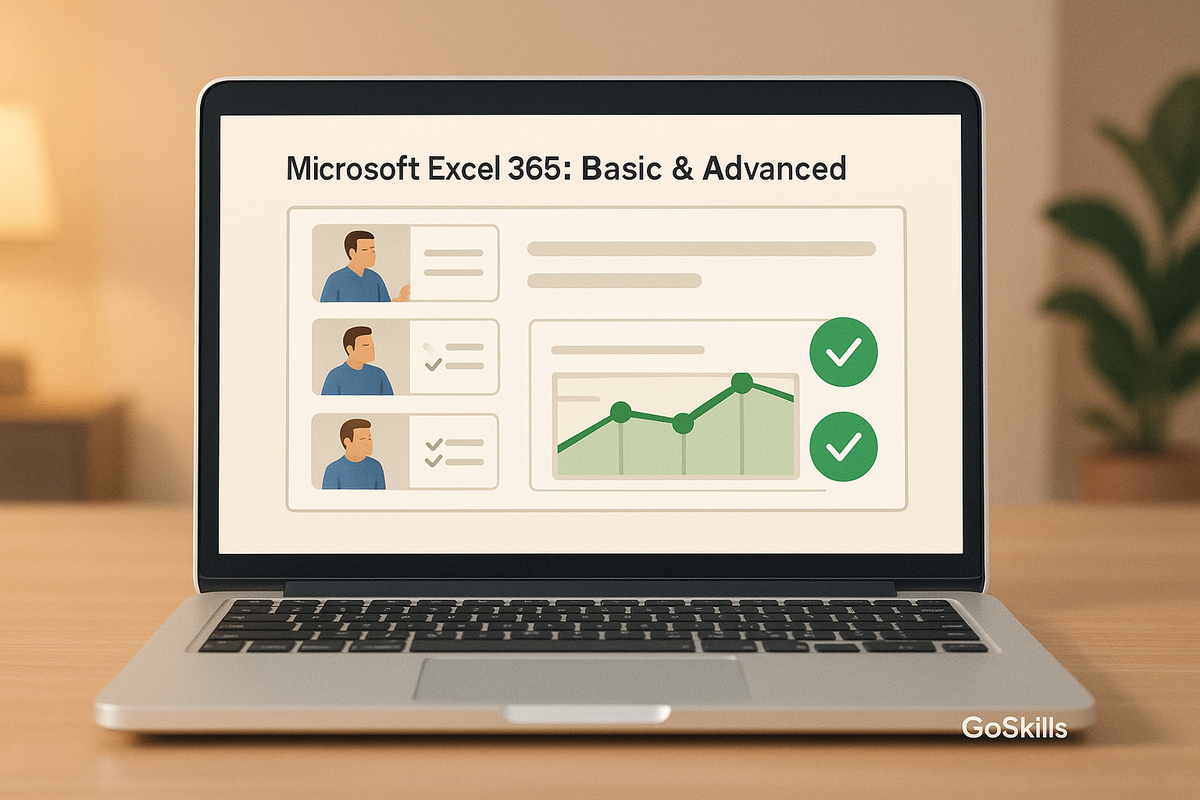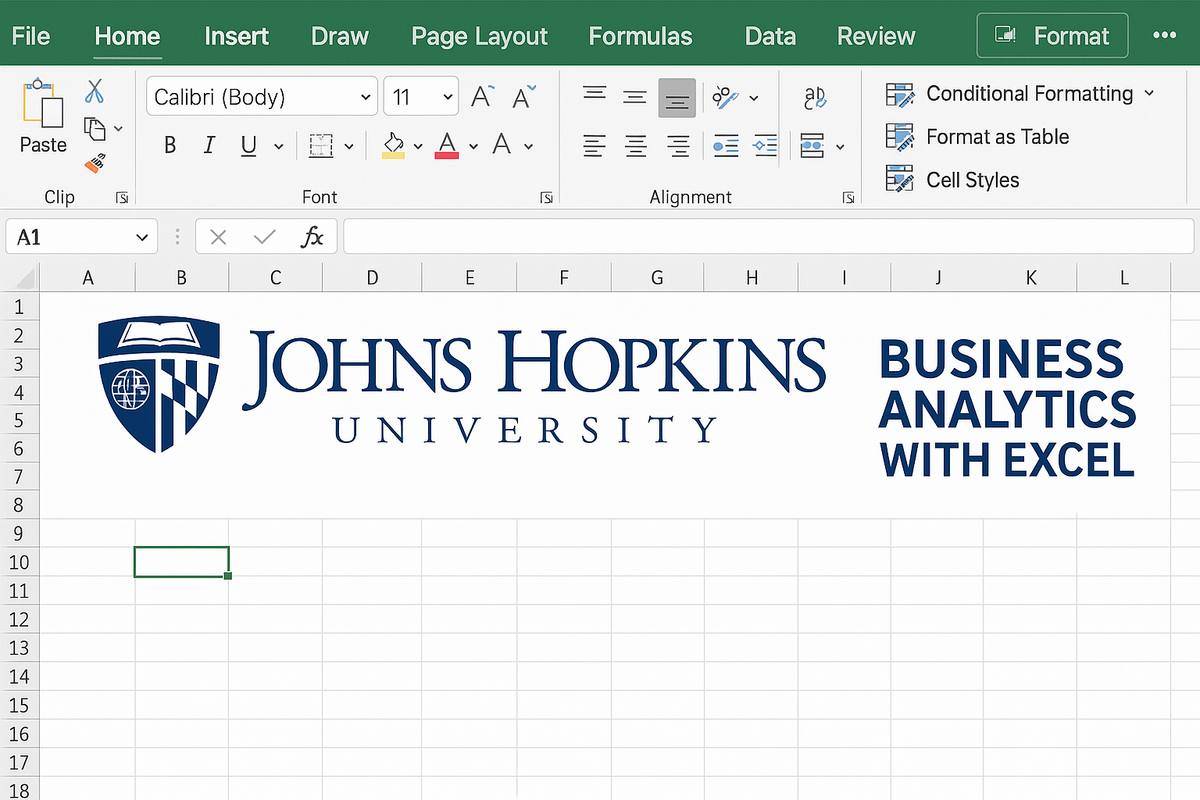

Microsoft Excel still tops hiring shortlists. A 2025 analysis of 12 million Indeed postings mentioned Excel in 531,000 ads—eight times as often as Python and nine times SQL. Yet the spreadsheet you used a few years ago has evolved: XLOOKUP replaces VLOOKUP, dynamic arrays spill results on the fly, Python now runs in cells, and Copilot drafts charts from plain-English prompts. In this guide, you’ll see why those upgrades matter, which up-to-date online Excel courses teach them, and how to finish with a certificate recruiters trust.
Excel may be 40 years old, but employers still ask for it first. A 2025 review of 12 million tech job ads on Indeed found Excel in 531,000 listings, compared with 67,000 for Python and 60,000 for SQL, according to Business Insider.
Microsoft keeps the grid fresh. Recent releases added XLOOKUP, dynamic array formulas, and “Python in Excel,” which became generally available to Microsoft 365 Business and Enterprise users in early 2025, according to a post on Microsoft’s Tech Community blog.
AI now lives on the ribbon. Copilot in Excel can suggest formulas, surface outliers, and even clean messy data with one click. These features reached web users in December 2024 and began rolling out to desktop builds in January 2025, according to Microsoft.
With these upgrades, Excel behaves more like a lightweight analytics platform than a traditional spreadsheet. Mastering the new functions, Python integration, and Copilot assistance lets you analyze data faster, present insights more clearly, and speak the same quantitative language as executives. These concrete advantages keep “advanced Excel” high on every hiring checklist in 2026.

Course creators now weave Microsoft 365 Copilot into almost every module. Instead of manually scrubbing data, learners type “remove duplicates and highlight outliers,” then watch Copilot generate the Power Query steps in seconds, according to Microsoft.
That pivot shifts training from memorising commands to crafting prompts. In a typical lesson, the instructor writes a plain-English request, Copilot returns a live formula or chart, and you refine the prompt until the answer fits. Because feedback is instant, the concept sticks.
Copilot also raises the bar for critical thinking. The tool can insert a VSTACK formula or even write Python code on the grid, thanks to February 2025 updates that added prompt suggestions and Python support in newer Excel builds. Good courses pause here, showing why the first draft works (or doesn’t) so you learn to spot a mismatched argument before it spreads through a workbook.
The net effect is clear: less rote drilling, more coaching. Master the prompts and you pilot the data instead of the other way around.
Python no longer sits in a separate notebook. Since March 2025, “Python in Excel” has been generally available for Enterprise and Business users on the web and Windows. You can import pandas, seaborn, or scikit-learn in a single cell and send the results straight to a PivotChart without extra installs.
Strong courses treat this fusion as a workflow decision, not a gimmick. They show when to stay native—Power Query for quick reshaping and dynamic arrays for lightweight math—then switch to Python for heavy lifting such as regression or text parsing.
The payoff is measurable: you keep analysis, automation, and visuals inside one .xlsx file that colleagues can open without add-ins. In short, Python in Excel turns power users into low-code data engineers.
Excel’s Current Channel receives new features two or three times a month, and every version is supported for only about 30 days before the next build ships. A video recorded in 2022 can already miss dozens of functions.
Smart course builders label each module “updated 2026” and push mini-refreshes whenever Microsoft ships a headline feature. If you study lookup logic today, you start with XLOOKUP, then learn VLOOKUP only for legacy files. The same cadence applies to dynamic arrays, LET, and LAMBDA.
Micro-lessons make the difference. When Microsoft introduced the PIVOTBY function or rolled out 14 new text-and-array functions in August 2024, good providers added a five-minute demo, a sample file, and a quick quiz instead of forcing a full re-enrolment.
This approach keeps your skills current, your certificate relevant, and saves you from relearning habits that Microsoft has already replaced.
A worthwhile course does two things: it meets you where you are and pushes you into Excel’s newest features. Anything less wastes hours.
Quick checklist: level-matched content, frequent updates, hands-on files, expert support, recognised credential, transparent pricing. Tick them all and your training budget is well spent.
Below are six well-reviewed programs that cover beginner to advanced skills. Figures are current as of October 2025.

GoSkills’ Excel course is ideal for busy professionals who prefer concise, digestible lessons. The program includes 61 bite-sized tutorials totaling just under six hours of video (5h 46m), designed to fit neatly into tight schedules. Covering everything from foundational concepts to advanced functions, it offers learners the flexibility to build Excel mastery at their own pace without feeling overwhelmed.
The course is CPD-accredited, meaning graduates receive a certificate worth 5.5 CPD hours—a meaningful credential for professional development portfolios. Learners can opt for a subscription at $39 per month or a one-time payment of $199. With interactive quizzes and short videos, GoSkills’ modular approach keeps engagement high and retention strong—perfect for anyone looking to improve their Excel fluency in spare moments between meetings.

Macquarie University’s “Excel Skills for Business” specialization on Coursera stands out for its academic credibility and thorough structure. Comprising four interconnected courses, it takes learners on a comprehensive journey from beginner to expert level across roughly 120 hours of material. Completing the program typically takes around three months at a pace of ten hours per week, offering a structured and measurable learning path.
Rated 4.9 stars from over 47,000 reviews and boasting more than 620,000 learners, this specialization is among Coursera’s most trusted Excel programs. The university-branded certificate can be proudly shared on LinkedIn and adds weight to any résumé. The course is available through Coursera Plus or as a $49-per-month subscription until completion. With graded projects and a capstone assignment, it’s an ideal choice for those who value academic rigor and practical skill-building in equal measure.

For those who already have a foundation in Excel and want to move into analytics, Johns Hopkins University’s “Business Analytics with Excel” is a concise yet powerful offering. The course runs for about 23 hours of video and is entirely self-paced, making it a great fit for busy professionals seeking to upskill efficiently. Its curriculum focuses on what-if models, regression analysis, and Solver optimization, giving learners the analytical tools to interpret business data more effectively.
Participants receive a Coursera certificate co-branded with Johns Hopkins, which reflects both technical competence and academic endorsement. The course doesn’t just teach Excel skills—it bridges them to data-driven decision-making, helping learners turn spreadsheets into insights. It’s a strong fast-track option for those who understand Excel’s basics but want to explore its analytical potential without committing to a lengthy program.

Kyle Pew’s “Microsoft Excel – Beginner to Advanced” course on Udemy has long been a student favorite—and for good reason. With 20 hours of on-demand video and lifetime access after purchase, it’s a one-stop resource that learners can revisit any time. The course structure walks through Excel fundamentals, intermediate tools, advanced data analysis techniques, and even VBA automation, making it a complete Excel training suite.
Rated 4.7 stars from nearly half a million reviews and serving over 1.6 million students, it’s one of Udemy’s top-performing offerings. Prices vary between $20 and $130, but frequent discounts make it highly affordable. Continuous updates—running through May 2025—ensure that learners always work with current Excel features. For those who appreciate a straightforward, pay-once model with long-term value, this course delivers impressive breadth and flexibility.

Leila Gharani’s “Excel for Data Analysis and Visualization” caters to intermediate users ready to take their skills to the next level. With 12 hours of video, it dives deep into advanced Excel capabilities such as Power Query, Power Pivot, and DAX formulas, while also emphasizing visual storytelling through dynamic dashboards. Gharani’s teaching style is crisp and practical, focusing on techniques professionals can apply immediately to real-world datasets.
This course is particularly suited for users already familiar with functions like INDEX and XMATCH, who now want to create interactive, visually compelling reports. Like other Udemy offerings, learners receive lifetime access after purchase, making it a smart investment for those looking to evolve from spreadsheet user to data communicator. If your goal is to make your Excel work both insightful and presentation-ready, Gharani’s course hits the mark.

LinkedIn Learning’s “Master Microsoft Excel” path offers a curated approach to Excel mastery through nine interconnected courses totaling about 14 hours of content. The platform’s learning paths are designed to be cohesive—each course builds logically on the last, leading learners from foundational techniques to advanced data manipulation and visualization tools.
The real advantage here is credential visibility. Upon completion, graduates earn a LinkedIn badge that integrates directly into their profiles, instantly signaling skill proficiency to recruiters and peers. Access comes through a $39-per-month subscription or via a free one-month trial, making it easy to explore before committing. For professionals aiming to upskill while strengthening their online presence, this pathway blends learning and career branding seamlessly.
As Excel evolves into a hybrid of spreadsheet, analytics engine, and AI-powered assistant, mastering its latest tools is no longer optional—it’s strategic. The best advanced Excel courses in 2026 don’t just teach formulas; they teach thinking with data. With Copilot automating the tedious work, dynamic arrays simplifying logic, and Python turning the grid into a coding canvas, the modern Excel expert bridges the gap between analysis and decision-making. Choose a course that keeps pace with Microsoft’s rapid updates, focuses on hands-on practice, and offers a credible certificate. By investing in the right training now, you future-proof your career with skills that employers will continue to demand for years to come.